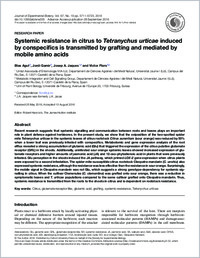Systemic resistance in citrus to Tetranychus urticae induced by conspecifics is transmitted by grafting and mediated by mobile amino acids
- Agut, Blas Metabolic Integration and Cell Signalling Group, Departament de Ciències Agràries i del Medi Natural, Universitat Jaume I (UJI),, Castelló de la Plana, Spain
- Gamir, Jordi Unit of Plant Biology, Université de Fribourg, Suisse
- Jaques, Josep A. Unitat Associada d’Entomologia IVIA-UJI, Departament de Ciències Agràries i del Medi Natural, Universitat Jaume I (UJI),, Castelló de la Plana, Spain
- Flors, Victor Metabolic Integration and Cell Signalling Group, Departament de Ciències Agràries i del Medi Natural, Universitat Jaume I (UJI),, Castelló de la Plana, Spain
-
01.10.2016
Published in:
- Journal of Experimental Botany. - 2016, vol. 67, no. 19, p. 5711–5723
English
Recent research suggests that systemic signalling and communication between roots and leaves plays an important role in plant defence against herbivores. In the present study, we show that the oviposition of the two-spotted spider mite Tetranychus urticae in the systemic leaves of citrus rootstock Citrus aurantium (sour orange) was reduced by 50% when a lower leaf was previously infested with conspecifics. Metabolomic and gene expression analysis of the root efflux revealed a strong accumulation of glutamic acid (Glu) that triggered the expression of the citrus putative glutamate receptor ( GRL ) in the shoots. Additionally, uninfested sour orange systemic leaves showed increased expression of glutamate receptors and higher amounts of jasmonic acid (JA) and 12-oxo-phytodienoic acid in plants that were previously infested. Glu perception in the shoots induced the JA pathway, which primed LOX-2 gene expression when citrus plants were exposed to a second infestation. The spider mite- susceptible citrus rootstock Cleopatra mandarin ( C. unshiu ) also expressed systemic resistance, although the resistance was less effective than the resistance in sour orange. Surprisingly, the mobile signal in Cleopatra mandarin was not Glu, which suggests a strong genotype-dependency for systemic signalling in citrus. When the cultivar Clemenules ( C. clementina ) was grafted onto sour orange, there was a reduction in symptomatic leaves and T. urticae populations compared to the same cultivar grafted onto Cleopatra mandarin. Thus, systemic resistance is transmitted from the roots to the shoots in citrus and is dependent on rootstock resistance.
- Faculty
- Faculté des sciences et de médecine
- Department
- Département de Biologie
- Language
-
- English
- Classification
- Biological sciences
- License
-
License undefined
- Identifiers
-
- RERO DOC 278409
- DOI 10.1093/jxb/erw335
- Persistent URL
- https://folia.unifr.ch/unifr/documents/305304
Statistics
Document views: 84
File downloads:
- pdf: 165
